The reproduction is not necessary to maintain the life of an individual organism, unlike the essential life processes such as nutrition, respiration, or excretion. Reproducing organisms create new individuals that look very much like themselves.
If body designs are to be similar, the blueprints for these designs should be similar. Thus, reproduction at its most basic level will involve making copies of the blueprints of body design.
The DNA (Deoxyribo Nucleic Acid) in the cell nucleus is the information source for making proteins. If the information is changed, different proteins will be made. Different proteins will eventually lead to altered body designs.
A basic event in reproduction is the creation of a DNA copy. Cells use chemical reactions to build copies of their DNA. This creates two copies of the DNA in a reproducing cell, and they will need to be separated from each other.
There could still be many other variations in the DNA copies that would not lead to such a drastic outcome.
The modes by which various organisms reproduce depend on the body design of the organisms.
For unicellular organisms, cell division, or fission, leads to the creation of new individuals. Many different patterns of fission have been observed. Many bacteria and protozoa simply split into two equal halves during cell division.
In organisms such as Amoeba, the splitting of the two cells during division can take place in any plane.
In multi-cellular organisms with relatively simple body organisation, simple reproductive methods can still work. Spirogyra, for example, simply breaks up into smaller pieces upon maturation. These pieces or fragments grow into new individuals. Multi-cellular organisms, therefore, need to use more complex ways of reproduction. A basic strategy used in multi-cellular organisms is that different cell types perform different specialised functions. Following this general pattern, reproduction in such organisms is also the function of a specific cell type.
If the individual is somehow cut or broken up into many pieces, many of these pieces grow into separate individuals known as regeneration.
Regeneration is carried out by specialised cells. These cells proliferate and make large numbers of cells. However, regeneration is not the same as reproduction, since most organisms would not normally depend on being cut up to be able to reproduce.
A bud develops as an outgrowth due to repeated cell division at one specific site. These buds develop into tiny individuals and when fully mature, detach from the parent body and become new independent individuals.
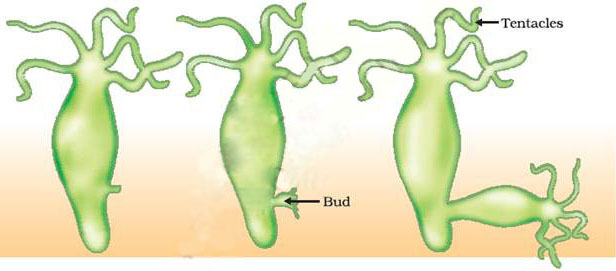
There are many plants in which parts like the Root, stem and leaves develop into new plants under appropriate conditions. vegetative propagation is used in methods such as layering or grafting to grow many plants like sugarcane, roses, or grapes for agricultural purposes. Plants raised by vegetative propagation can bear flowers and fruits earlier than those produced from seeds. Such methods also make possible the propagation of plants such as banana, orange, rose and jasmine that have lost the capacity to produce seeds.
Another advantage of vegetative propagation is that all plants produced are genetically similar enough to the parent plant to have all its characteristics.
Similarly buds produced in the notches along the leaf margin of Bryophyllum fall on the soil and develop into new plants.
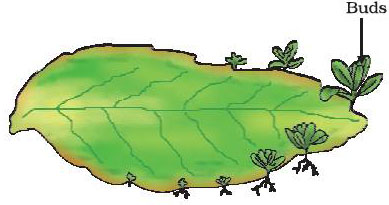
The spores are covered by thick walls that protect them until they come into contact with another moist surface and can begin to grow.
The tiny blob-on-a-stick structures are involved in reproduction. The blobs are sporangia, which contain cells, or spores, that can eventually develop into new Rhizopus individuals.
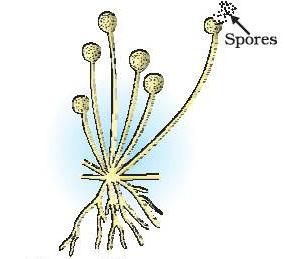
We leant that the reproduction depends on the involvement of two individuals before a new generation can be created. Bulls alone cannot produce new calves, nor can hens alone produce new chicks. In such cases, both sexes, males and females, are needed to produce new generations.
The creation of two new cells from one involves copying of the DNA as well as of the cellular apparatus. The DNA copying mechanism, as we have noted, cannot be absolutely accurate, and the resultant errors are a source of variations in populations of organisms.
While DNA-copying mechanisms are not absolutely accurate, they are precise enough to make the generation of variation a fairly slow process. If the DNA copying mechanisms were to be less accurate, many of the resultant DNA copies would not be able to work with the cellular apparatus, and would die. So how can the process of making variants are speeded up? Each new variation is made in a DNA copy that already has variations accumulated from previous generations. Thus, two different individuals in a population would have quite different patterns of accumulated variations.
The sexual mode of reproduction incorporates such a process of combining DNA from two different individuals during reproduction.
When these germ-cells from two individuals combine during sexual reproduction to form a new individual, it results in reestablishment of the number of chromosomes and the DNA content in the new generation.
The reproductive parts of angiosperms are located in the flower. There are the different parts of a flower – sepals, petals, stamens and pistil. Stamens and pistil are the reproductive parts of a flower which contain the germ-cells.
The flower may be unisexual (papaya, watermelon) when it contains either stamens or pistil or bisexual (Hibiscus, mustard) when it contains both stamens and pistil.
Stamen is the male reproductive part and it produces pollen grains that are yellowish in colour.
Pistil is present in the centre of a flower and is the female reproductive part. It is made of three parts.
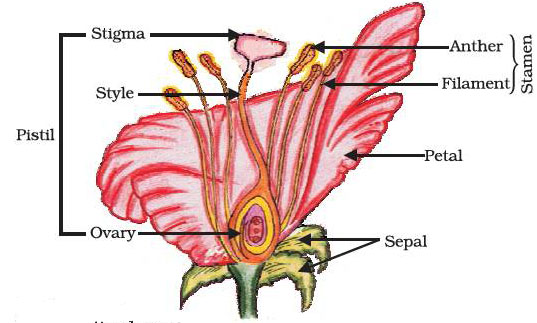
The swollen bottom part is the ovary, middle elongated part is the style and the terminal part which may be sticky is the stigma. The ovary contains ovules and each ovule has an egg cell. The male germ-cell produced by pollen grain fuses with the female gamete present in the ovule. This fusion of the germ-cells or fertilisation gives us the zygote which is capable of growing into a new plant.
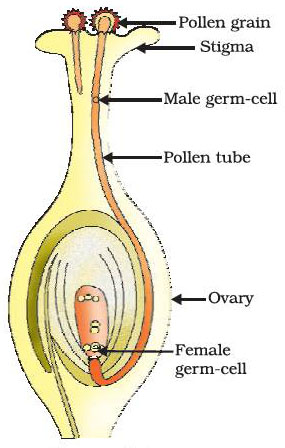
If the pollen is transferred from one flower to another, it is known as crosspollination. This transfer of pollen from one flower to another is achieved by agents like wind, water or animals.
After fertilisation, the zygote divides several times to form an embryo within the ovule. The ovule develops a tough coat and is gradually converted into a seed. The ovary grows rapidly and ripens to form a fruit. Meanwhile, the petals, sepals, stamens, style and stigma may shrivel and fall off.
The seed contains the future plant or embryo which develops into a seedling under appropriate conditions. This process is known as germination.
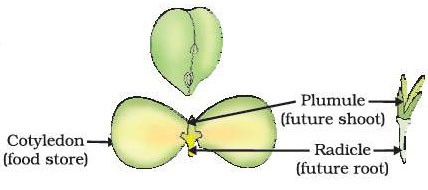
There are the different varieties of modes that different species use for reproduction.
We have learnt changes that take place in your body earlier in Class and we notice that our height has increased continuously from early age till now. We acquire teeth; we even lose the old, so-called milk teeth and acquire new ones.
All of these are changes that can be grouped under the general process of growth, in which the body becomes larger. But in early teenage years, a whole new set of changes occurs that cannot be explained simply as body enlargement. Instead, the appearance of the body changes. Proportions change, new features appear, and so do new sensations.
Some of these changes are common to both boys and girls. Thinner hair can also appear on legs and arms, as well as on the face. The skin frequently becomes oily and we might begin to develop pimples.
There are also changes taking place that are different between boys and girls. In girls, breast size begins to increase, with darkening of the skin of the nipples at the tips of the breasts. Also, girls begin to menstruate at around this time. Boys begin to have new thick hair growth on the face and their voices begin to crack. Further, the penis occasionally begins to become enlarged and erect, either in daydreams or at night.
All of these changes take place slowly, over a period of months and years. They do not happen all at the same time in one person, nor do they happen at an exact age. In some people, they happen early and quickly, while in others, they can happen slowly. All of these changes are aspects of the sexual maturation of the body. As the rate of general body growth begins to slow down, reproductive tissues begin to mature. This period during adolescence is called puberty.
The sexual mode of reproduction means that germ-cells from two individuals have to join together. This can happen by the external release of germ-cells from the bodies of individuals, as happens in flowering plants. Or it can happen by two individuals joining their bodies together for internal transfer of germ-cells for fusion, as happens in many animals.
Many changes during puberty, such as new hair-growth patterns, are signals that sexual maturation is taking place.
The actual transfer of germ-cells between two people needs special organs for the sexual act, such as the penis when it is capable of becoming erect. In mammals such as humans, the baby is carried in the mother's body for a long period, and will be breast-fed later. The female reproductive organs and breasts will need to mature to accommodate these possibilities.
The male reproductive system consists of portions which produce the germ-cells and other portions that deliver the germ-cells to the site of fertilization.
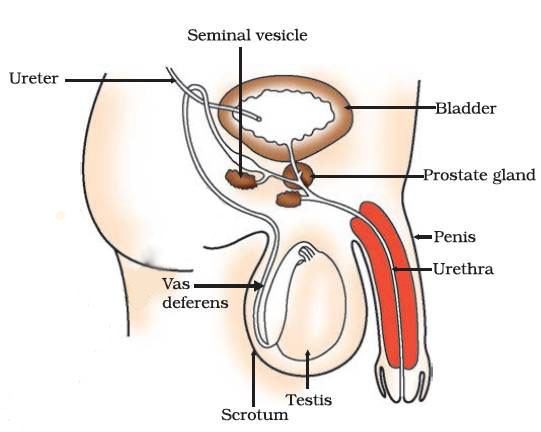
The formation of germ-cells or sperms takes place in the testes. These are located outside the abdominal cavity in scrotum because sperm formation requires a lower temperature than the normal body temperature.
The sperms formed are delivered through the vas deferens which unites with a tube coming from the urinary bladder. The urethra thus forms a common passage for both the sperms and urine. The sperms are tiny bodies that consist of mainly genetic material and a long tail that helps them to move towards the female germ-cell.
The female germ-cells or eggs are made in the ovaries. They are also responsible for the production of some hormones.
When a girl is born, the ovaries already contain thousands of immature eggs. On reaching puberty, some of these start maturing. One egg is produced every month by one of the ovaries. The egg is carried from the ovary to the womb through a thin oviduct or fallopian tube. The two oviducts unite into an elastic bag-like structure known as the uterus. The uterus opens into the vagina through the cervix.
The sperms enter through the vaginal passage during sexual intercourse. They travel upwards and reach the oviduct where they may encounter the egg. The fertilized egg (zygote) starts dividing and form a ball of cells or embryo. The embryo is implanted in the lining of the uterus where they continue to grow and develop organs to become foetus.
The embryo gets nutrition from the mother's blood with the help of a special tissue called placenta. This is a disc which is embedded in the uterine wall. It contains villi on the embryo's side of the tissue. On the mother's side are blood spaces, which surround the villi. This provides a large surface area for glucose and oxygen to pass from the mother to the embryo. The developing embryo will also generate waste substances which can be removed by transferring them into the mother's blood through the placenta. The development of the child inside the mother's body takes approximately nine months. The child is born as a result of rhythmic contractions of the muscles in the uterus.
The ovary releases one egg every month, the uterus also prepares itself every month to receive a fertilized egg. Thus its lining becomes thick and spongy.
